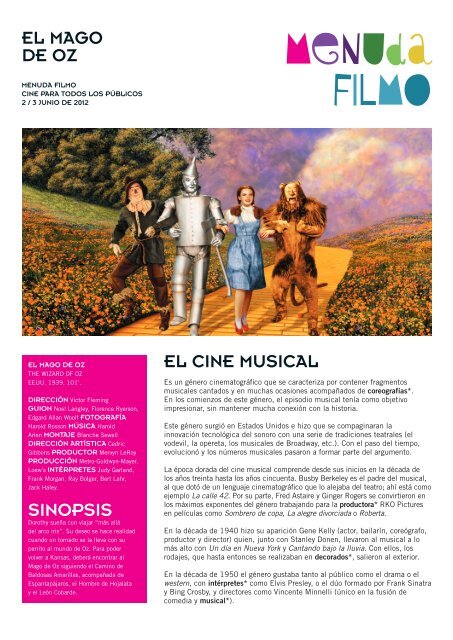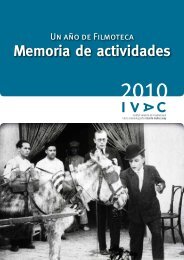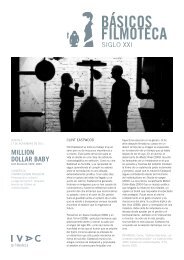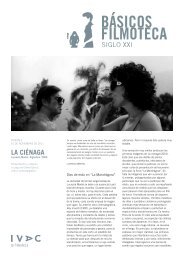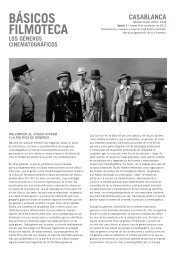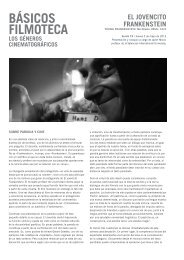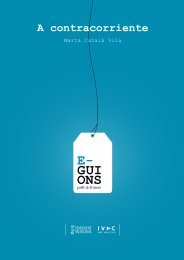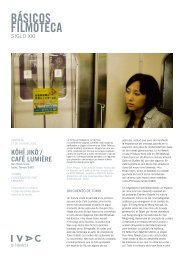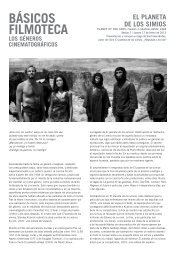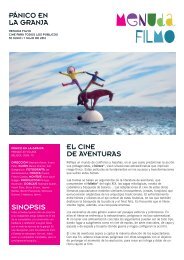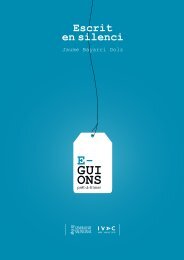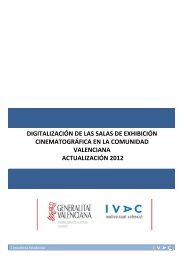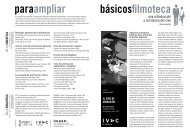You also want an ePaper? Increase the reach of your titles
YUMPU automatically turns print PDFs into web optimized ePapers that Google loves.
EL MAGO<br />
DE OZ<br />
MENUDA FILMO<br />
CINE PARA TODOS LOS PÚBLICOS<br />
2 / 3 JUNIO DE 2012<br />
EL MAGO DE OZ<br />
THE WIZARD OF OZ<br />
EEUU. 1939. 101’.<br />
DIRECCIÓN Victor Fleming<br />
GUION Noel Langley, Florence Ryerson,<br />
Edgard Allan Woolf FOTOGRAFÍA<br />
Harold Rosson MÚSICA Harold<br />
Arlen MONTAJE Blanche Sewell<br />
DIRECCIÓN ARTÍSTICA Cedric<br />
Gibbons PRODUCTOR Mervyn LeRoy<br />
PRODUCCIÓN Metro-Goldwyn-Mayer,<br />
Loew’s INTÉRPRETES Judy Garland,<br />
Frank Morgan, Ray Bolger, Bert Lahr,<br />
Jack Haley.<br />
SINOPSIS<br />
Dorothy sueña con viajar “más allá<br />
<strong>de</strong>l arco iris”. Su <strong>de</strong>seo se hace realidad<br />
cuando un tornado se la lleva con su<br />
perrito al mundo <strong>de</strong> <strong>Oz</strong>. Para po<strong>de</strong>r<br />
volver a Kansas, <strong>de</strong>berá encontrar al<br />
Mago <strong>de</strong> <strong>Oz</strong> siguiendo el Camino <strong>de</strong><br />
Baldosas Amarillas, acompañada <strong>de</strong><br />
Espantapájaros, el Hombre <strong>de</strong> Hojalata<br />
y el León Cobar<strong>de</strong>.<br />
EL CINE MUSICAL<br />
Menuda<br />
Filmo<br />
Es un género cinematográfico que se caracteriza por contener fragmentos<br />
musicales cantados y en muchas ocasiones acompañados <strong>de</strong> coreografías*.<br />
En los comienzos <strong>de</strong> este género, el episodio musical tenía como objetivo<br />
impresionar, sin mantener mucha conexión con la historia.<br />
Este género surgió en Estados Unidos e hizo que se compaginaran la<br />
innovación tecnológica <strong>de</strong>l sonoro con una serie <strong>de</strong> tradiciones teatrales (el<br />
vo<strong>de</strong>vil, la opereta, los musicales <strong>de</strong> Broadway, etc.). Con el paso <strong>de</strong>l tiempo,<br />
evolucionó y los números musicales pasaron a formar parte <strong>de</strong>l argumento.<br />
La época dorada <strong>de</strong>l cine musical compren<strong>de</strong> <strong>de</strong>s<strong>de</strong> sus inicios en la década <strong>de</strong><br />
los años treinta hasta los años cincuenta. Busby Berkeley es el padre <strong>de</strong>l musical,<br />
al que dotó <strong>de</strong> un lenguaje cinematográfico que lo alejaba <strong>de</strong>l teatro; ahí está como<br />
ejemplo La calle 42. Por su parte, Fred Astaire y Ginger Rogers se convirtieron en<br />
los máximos exponentes <strong>de</strong>l género trabajando para la productora* RKO Pictures<br />
en películas como Sombrero <strong>de</strong> copa, La alegre divorciada o Roberta.<br />
En la década <strong>de</strong> 1940 hizo su aparición Gene Kelly (actor, bailarín, coreógrafo,<br />
productor y director) quien, junto con Stanley Donen, llevaron al musical a lo<br />
más alto con Un día en Nueva York y Cantando bajo la lluvia. Con ellos, los<br />
rodajes, que hasta entonces se realizaban en <strong>de</strong>corados*, salieron al exterior.<br />
En la década <strong>de</strong> 1950 el género gustaba tanto al público como el drama o el<br />
western, con intérpretes* como <strong>El</strong>vis Presley, o el dúo formado por Frank Sinatra<br />
y Bing Crosby, y directores como Vincente Minnelli (único en la fusión <strong>de</strong><br />
comedia y musical*).
DESCUBRIENDO<br />
EL CINE<br />
MUSICAL<br />
En el cine musical* la música<br />
está muy unida a la historia, los<br />
personajes e incluso a los mismos<br />
títulos <strong>de</strong> las películas. ¿Podrías<br />
relacionar cada película con el<br />
fragmento <strong>de</strong> canción que te<br />
CANCIÓN DE LA PELÍCULA...<br />
proponemos? EL COLOR<br />
CANCIÓN DE LA PELÍCULA...<br />
Un<strong>de</strong>r the sea, un<strong>de</strong>r the sea<br />
Darlin’ it’s better down where it’s wetter<br />
Take it from me.<br />
Bajo el mar, bajo el mar<br />
Hay bailarines, son los <strong>de</strong>lfines<br />
Ven a bailar.<br />
CANCIÓN DE LA PELÍCULA...<br />
New York, New York, a visitor’s place,<br />
Where no one lives on account of the pace,<br />
But seven millions are screaming for space.<br />
New York, New York, it’s a visitor’s place!<br />
A<br />
Nueva York, Nueva York, un lugar para visitar,<br />
Don<strong>de</strong> cada uno vive a su ritmo<br />
Pero siete millones gritan por espacio<br />
Nueva York, Nueva York, un lugar para visitar.<br />
If ever oh ever a Wiz!<br />
there was The Wizard of <strong>Oz</strong> is one because,<br />
Because, because, because, because, because.<br />
Because of the won<strong>de</strong>rful things he does.<br />
We’re off to see the Wizard.<br />
The Won<strong>de</strong>rful Wizard of <strong>Oz</strong>.<br />
Si existe un <strong>mago</strong><br />
<strong>El</strong> <strong>mago</strong> <strong>de</strong> <strong>Oz</strong> es uno <strong>de</strong> ellos porque<br />
Porque, porque, porque, porque, porque<br />
Porque hace cosas maravillosas<br />
Nos vamos a ver al Mago.<br />
Al maravilloso Mago <strong>de</strong> <strong>Oz</strong><br />
B D<br />
CANCIÓN DE LA PELÍCULA...<br />
I’m laughing at clouds<br />
So dark up above<br />
The sun’s in my heart<br />
And I’m ready for love<br />
Me río <strong>de</strong> las nubes<br />
Tan oscuras allá arriba<br />
<strong>El</strong> sol está en mi corazón<br />
Y estoy listo para el amor.<br />
Fotograma ___ Cantando bajo la lluvia (Singin’ in the rain, S. Donen y G. Kelly, 1952)<br />
Fotograma ___ <strong>El</strong> <strong>mago</strong> <strong>de</strong> <strong>Oz</strong> (The Wizard of <strong>Oz</strong>, Victor Fleming, 1939)<br />
Fotograma ___ La Sirenita (The Little Mermaid, Ron Clements y John Musker, 1989)<br />
Fotograma ___ Un día en Nueva York (On the Town, S. Donen y G. Kelly, 1949)<br />
C<br />
En su origen, al igual que la fotografía, el cine<br />
era en blanco y negro, pero siempre aspiró a<br />
ser en color. Ya en 1896, se pintaba a mano<br />
cada fotograma <strong>de</strong> la película. Este proceso<br />
era muy trabajoso por el tamaño reducido <strong>de</strong><br />
los fotogramas y porque una película <strong>de</strong> menos<br />
<strong>de</strong> un minuto emplea unos 1.000 fotogramas.<br />
En 1905 la productora* Pathé convirtió<br />
el sistema manual en mecánico permitiendo<br />
realizar numerosas copias coloreadas <strong>de</strong> cada<br />
film. Este sistema se utilizó hasta 1930.<br />
En general se utilizaban sistemas menos<br />
trabajosos como el entintado, que se basa en<br />
dar baños <strong>de</strong> color directamente al rollo <strong>de</strong> la<br />
película (soporte físico). Dependiendo <strong>de</strong>l<br />
color utilizado se pretendía reflejar un estado<br />
<strong>de</strong> ánimo u otro. También se utilizaba para<br />
reflejar un momento concreto: azul si la<br />
escena sucedía <strong>de</strong> noche, amarillo si era<br />
<strong>de</strong> día o rojo cuando había fuego.<br />
Los avances más importantes se lograron<br />
adaptando al cine los <strong>de</strong>scubrimientos <strong>de</strong> la<br />
fotografía en color. Mediante la superposición<br />
<strong>de</strong> los colores rojo, azules y ver<strong>de</strong>, se podían<br />
reproducir todos los <strong>de</strong>más. Para que a las<br />
personas (<strong>de</strong>bido a nuestro funcionamiento<br />
ocular) nos <strong>de</strong> la impresión <strong>de</strong> que la película<br />
contiene diferentes colores es necesario que<br />
las imágenes se proyecten con mucha rapi<strong>de</strong>z.<br />
La revolución <strong>de</strong>l color en el cine llegó<br />
con la compañía Technicolor, que consiguió<br />
reproducir todos los colores en una única<br />
película. Con este método obtuvieron<br />
un rojo brillante que reforzó la intensidad<br />
dramática y se convirtió en la marca <strong>de</strong><br />
i<strong>de</strong>ntidad <strong>de</strong>l Technicolor. Fue en los inicios<br />
<strong>de</strong> esta técnica cuando se rodó <strong>El</strong> Mago <strong>de</strong><br />
<strong>Oz</strong>. Las escenas en Kansas están rodadas<br />
en sepia, mientras que aquellas en el País<br />
<strong>de</strong> <strong>Oz</strong> se rodaron con cámaras Technicolor,<br />
por eso vemos brillar los zapatos rojos<br />
<strong>de</strong> Dorothy. Combinando ambas técnicas<br />
consiguen diferenciar el mundo real <strong>de</strong>l<br />
fantástico; ejemplo <strong>de</strong> cómo el color se ha<br />
utilizado a lo largo <strong>de</strong> la historia <strong>de</strong>l cine<br />
como herramienta para provocar sensaciones<br />
<strong>de</strong>terminadas en el espectador.
AMPLIANDO<br />
VOCABULARIO<br />
¡Encuentra en esta Sopa <strong>de</strong> Letras las nuevas palabras sobre cine que has<br />
aprendido con <strong>El</strong> Mago <strong>de</strong> <strong>Oz</strong>!<br />
ExPRESA CON<br />
EL COLOR<br />
¿Podrías pintar cada<br />
elemento <strong>de</strong>l color que<br />
correspon<strong>de</strong>? ¡Recuerda que<br />
a los colores se les asocian<br />
cualida<strong>de</strong>s! Menciona algunos<br />
valores o sentimientos que<br />
relaciones normalmente con<br />
el negro, el amarillo y el rojo.<br />
AMARILLO<br />
NEGRO<br />
ROJO<br />
VOCABULARIO<br />
COREOGRAFÍA<br />
Conjunto <strong>de</strong> pasos y movimientos<br />
coordinados realizados por los<br />
intérpretes <strong>de</strong> un filme en una<br />
escena musical o <strong>de</strong> acción<br />
violenta.<br />
DECORADO<br />
Conjunto <strong>de</strong> elementos<br />
organizados y colocados<br />
<strong>de</strong>lante <strong>de</strong> la cámara para crear<br />
un ambiente <strong>de</strong>terminado.<br />
Mediante construcciones o<br />
dibujos y pinturas se simulan<br />
arquitecturas, espacios o<br />
paisajes.<br />
PRODUCTORA<br />
Empresa encargada <strong>de</strong> la<br />
financiación, promoción y, en<br />
ocasiones, <strong>de</strong> la distribución<br />
<strong>de</strong> la película.<br />
INTÉRPRETES / REPARTO<br />
Conjunto <strong>de</strong> actores y<br />
actrices, tanto protagonistas<br />
como secundarios y extras, que<br />
trabajan en una película.<br />
COMEDIA MUSICAL<br />
Subgénero <strong>de</strong>l musical en el que<br />
la trama es ofrecida en clave <strong>de</strong><br />
comedia, con su correspondiente<br />
happy end (final feliz).<br />
ExTRA / FIGURANTE<br />
Intérprete que aparece en el<br />
film pero que no tiene diálogos.<br />
PERSONAJE SECUNDARIO<br />
Aunque importante en la<br />
narración, participa en menor<br />
medida en la acción y muchas<br />
veces es un complemento o<br />
apoyo a los protagonistas.
PERSONAJES<br />
DOROThy (Judy Garland)<br />
Esta niña huérfana sueña con<br />
viajar lejos <strong>de</strong> la granja don<strong>de</strong><br />
vive al cuidado <strong>de</strong> sus tíos.<br />
Haría cualquier cosa por su<br />
perrito Totó.<br />
ESPANTAPáJAROS (Ray Bolger)<br />
Amable y bonachón, <strong>de</strong>sea<br />
tener un cerebro. Odia el fuego.<br />
hOMBRE DE hOJALATA<br />
(Jack haley)<br />
Necesita aceite <strong>de</strong> vez<br />
en cuando para no quedarse<br />
encajado. Quiere pedirle<br />
al Mago un corazón.<br />
LEÓN (Bert Lahr)<br />
Muy sensible. Necesita que<br />
el <strong>mago</strong> le <strong>de</strong> coraje para ser un<br />
buen león.<br />
MAGO DE OZ (Frank Morgan)<br />
<strong>El</strong> po<strong>de</strong>roso <strong>mago</strong> que todo<br />
lo pue<strong>de</strong> ayudará a los<br />
protagonistas.<br />
BRUJA DEL OESTE<br />
(Margaret hamilton)<br />
La malvada bruja ansía los<br />
zapatos <strong>de</strong> su hermana, y hará<br />
cualquier cosa para quitárselos<br />
a Dorothy.<br />
hADA DEL NORTE (Billie Burke)<br />
Ayudará a Dorothy en su aventura<br />
por la Tierra <strong>de</strong> <strong>Oz</strong>.<br />
TÍA EMMA y TÍO ENRIqUE<br />
(Clara Blandick y<br />
Charley Grapewin)<br />
Los tíos <strong>de</strong> Dorothy la quieren<br />
mucho, pero trabajan tanto que<br />
no pue<strong>de</strong>n ocuparse <strong>de</strong> Dorothy<br />
todo lo que a ella le gustaría.<br />
La filmografía propuesta como<br />
complemento a esta sesión <strong>de</strong> Menuda<br />
Filmo está disponible a través <strong>de</strong>l servicio<br />
<strong>de</strong> Vi<strong>de</strong>oteca <strong>de</strong>l <strong>IVAC</strong><br />
Dr. García Brustenga, 3 · Valencia<br />
http://arxiu.ivac-lafilmoteca.es/<strong>IVAC</strong>/<br />
vi<strong>de</strong>oteca_ivac@gva.es<br />
West Si<strong>de</strong> Story, Robert Wise, 1961<br />
FILMOGRAFÍA<br />
DEL CINE MUSICAL<br />
<strong>El</strong> cantante <strong>de</strong> Jazz (The Jazz Singer, Alan<br />
Crossland, 1927)<br />
La calle 42 (Forty Second Street, Lloyd Bacon,<br />
1933)<br />
<strong>El</strong> gran Ziegfeld (The Great Ziegfeld, Robert Z.<br />
Leonard, 1936)<br />
<strong>El</strong> <strong>mago</strong> <strong>de</strong> <strong>Oz</strong> (The Wizard of <strong>Oz</strong>, Victor<br />
Fleming, 1939)<br />
Noche y día (Night and Day, Michael Curtiz,<br />
1946)<br />
<strong>El</strong> pirata (The Pirate, Vincent Minnelli, 1948)<br />
Las zapatillas rojas (The Red Shoes, Michael<br />
Powell y Emeric Presburger, 1948)<br />
Un día en Nueva York (On the Town, Stanley<br />
Donen y Gene Kelly, 1949)<br />
Un americano en París (An American in Paris,<br />
Vincente Minnelli, 1951)<br />
Cantando bajo la lluvia (Singin’ in the Rain,<br />
Stanley Donen y Gene Kelly, 1952)<br />
Brigadoon (Vincent Minnelli, 1953)<br />
Los caballeros las prefieren rubias (Gentleman<br />
Prefer Blon<strong>de</strong>s, Howard Hawks, 1953)<br />
Melodías <strong>de</strong> Broadway (The Band Wagon,<br />
Vincent Minnelli, 1953)<br />
Siete novias para siete hermanos (Seven<br />
Bri<strong>de</strong>s for Seven Brothers, Stanley Donen,<br />
1954)<br />
Papá piernas largas (Daddy Long Legs, Jean<br />
Negulesco, 1955)<br />
<strong>El</strong> rock <strong>de</strong> la cárcel (Jailhouse Rock, Richard<br />
Thorpe, 1957)<br />
<strong>El</strong> multimillonario (Let’s Make Love, George<br />
Cukor, 1960)<br />
West Si<strong>de</strong> Story (Robert Wise, 1961)<br />
Tómbola (Luis Lucia, 1962)<br />
Cuatro gangsters <strong>de</strong> Chicago (Robin and the<br />
Seven Hoods, Gordon, Douglas, 1964)<br />
My Fair Lady (George Cukor, 1964)<br />
Sonrisas y lágrimas (The Sound of Music,<br />
Robert Wise, 1965)<br />
Chitty chitty, bang bang (Ken Hughes, 1968)<br />
Oliver (Carol Reed, 1968)<br />
Hello Dolly! (Gene Kelly, 1969)<br />
La leyenda <strong>de</strong> la ciudad sin nombre (Paint<br />
your Wagon, Joshua Logan, 1969)<br />
<strong>El</strong> violinista en el tejado (The Fiddler on the<br />
Roof, Norman Jewinson, 1971)<br />
Cabaret (Bob Fosse, 1972)<br />
<strong>El</strong> fantasma <strong>de</strong>l paraíso (The Phantom of the<br />
Paradise, Brian <strong>de</strong> Palma, 1974)<br />
New York, New York (Martin Scorsese, 1977)<br />
Grease (Randal Kleiser, 1978)<br />
Hair (Milos Forman, 1979)<br />
The Blues Brothers (John Landis, 1980)<br />
Victor o Victoria (Victor Victoria, Blake<br />
Edwards, 1982)<br />
Cotton Club (Francis Ford Coppola, 1984)<br />
Pesadilla antes <strong>de</strong> navidad (The Nightmare<br />
Before Christmas, Henry Selick, 1993)<br />
Todos dicen I Love You (Woody Allen, 1996)<br />
On connaît la chanson (Alain Resnais, 1997)<br />
Moulin Rouge (Baz Luhrman, 2001)<br />
Al otro lado <strong>de</strong> la cama (Emilio Martínez-<br />
Lázaro, 2002)<br />
Chicago (Rob Marshall, 2002)<br />
8 mujeres (8 femmes, Fraçois <strong>Oz</strong>on, 2002)<br />
Los chicos <strong>de</strong>l coro (Les Choristes, Christophe<br />
Barratier, 2004)<br />
Las guías didácticas <strong>de</strong> Menuda Filmo son<br />
un proyecto <strong>de</strong>sarrollado por el Institut Valencià <strong>de</strong> l’Audiovisual<br />
i <strong>de</strong> la Cinematografia Ricardo Muñoz Suay


